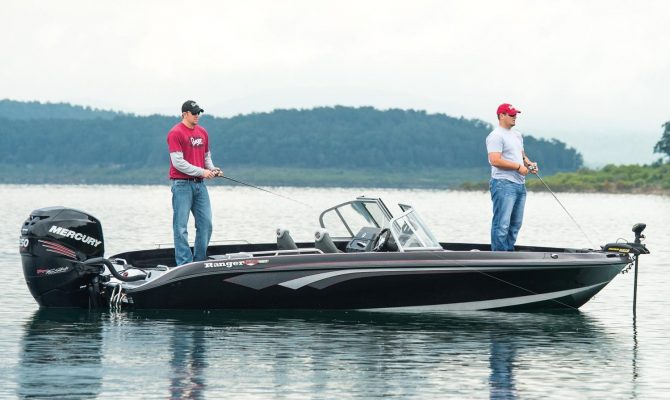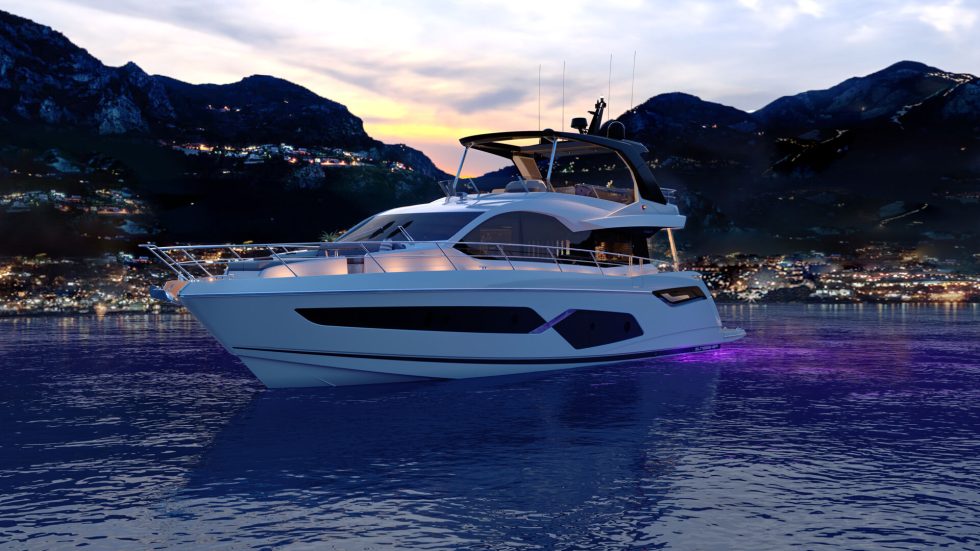Starting in the bow, the all-new design provides molded-in tool holders, a flat to accommodate any known trolling motor, another flat to mount a 12-inch sounder, a large portside compartment with air circulation system to dry out your wet gear, and a redesigned scupper system around each deck hatch that channels water down to the centerline bilge and out.
On-deck rod storage protects the rod tips in the gunwale. Belowdecks is locking rod storage for 12 sticks. With everything built into the bow of the 620 FS, it’s amazing that it remains so open and uncluttered for fishing.
Added to the passenger side of the dual console are receivers for four large Plano tackle boxes. At calf level, outboard, Ranger integrated another storage space for three rods up to eight feet long.
The ergonomically redesigned helm features all digital switching, space for flush-mounting a 12-inch multifunction display, and built-in room for an electronic engine monitoring display and catchall.
One feature I particularly like — the new rubber non-skid sole — makes cleaning easy; it’s softer on your knees than the old fiberglass non-skid, and boy does it grip! Ranger now stows all the batteries on centerline along with the charger. This has a huge impact on improving overall performance and stability by putting the center of gravity in a better place. You also access all your pumps here.
You still get the mammoth livewell aft, along with the large dry-storage compartments, but the transom itself has been raised so stern seas, wakes and back-trolling all can be accomplished more safely. And of course, every Ranger comes with a standard swim ladder that can be deployed from the water in case you find yourself there unexpectedly.
This 620 redesign also incorporates two inches deeper draft and four inches wider beam. While that may sound minimal, but you’ll notice the difference when fishing or when your wife and kids all come aboard.

The 620 FS rates up to 250 horsepower, and that’s what we drove at Yamaha’s top-secret test facility. The boat planed in four seconds and topped out at 60 mph (6,000 rpm) in calm water. At that speed, the Yamaha 250 with 15×20 Saltwater Series II prop made 2.5 mpg.
An optimal cruise speed of 28 mph (3,000 rpm) returned 4.25 mpg. That offers a range of almost 200 miles between fills, assuming 90 percent usable fuel. Pretty darn good efficiency for such a big outboard. And despite the big power, Ranger has done an exceptional job of cleaning up the transom, leaving only a single rigging tube visible. No fuel line, no hydraulic hoses — just clean working space.
Ranger uses a construction method it calls “Pultrusion,” a means of sucking a measured amount of resin through the dry fiberglass layup. This guarantees an exacting resin-to-glass ratio while completely eliminating the possibility of voids and air bubbles, making for a laminate both stronger and lighter than hand-laid hulls.
What most impressed me, though, was the Ranger 620’s handling. Unlike so many bass boats that can be squirrely, the 620 proved rock-solid with nary a running idiosyncrasy. It handled head seas like a larger, heavier boat, cutting through them smoothly and with little spray. Hard turns bled speed, keeping us securely in our seats.
Anglers will especially like that, when drifting or slow-trolling, the 620 displays remarkably little hull or chine slap noise. Other fishing-friendly details include a built-in net/gaff holder between the two front seats, usable boxes aft now that the four-bank charger has been moved amidships and even a hideaway, 32-inch, aluminum fish ruler.
Overall, I have to rate this as one of the best designed, best performing Ranger boats I’ve tested. I can only assume that the FS in the model designation must stand for Fishes Superbly.
Author: Dean Travis Clarke is a regular contributor to HeartLand Boating
Ranger 620 FS
LOA: 20’5”
Beam: 8’4”
Draft: 1’4”
Dry Weight: 2,240 lbs.
Fuel Capacity: 51 gals.
Max HP: 250 hp
Base Price: $67,000 (w/Yamaha 250)
www.rangerboats.com




